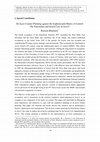Papers by Rassem Khamaisi
Sustainability in planning and development consists one of the main issues placed on the agendas ... more Sustainability in planning and development consists one of the main issues placed on the agendas of planners, development and decision makers. Since the beginning of the 1990’s, and particularly after Rio de Janeiro summit 1992 and, later, Agenda 21 of the UN, public awareness has grown. The notion of sustainability is based on environmental and ecological considerations which lead us as people, communities and states, to look at what is happening to our environmental system in a holistic approach. Part of this environment is the urban system, which includes the environmental, physical, social and economic fabrics.
Jerusalem and the Principles of Conflict Urbanism Almost eight decades of violent urban conflict ... more Jerusalem and the Principles of Conflict Urbanism Almost eight decades of violent urban conflict have transformed Jerusalem into an extreme spatial configuration. From a Western perspective, Jerusalem is often regarded as unique: a place where colonial and terrorist violence blur distinctions between the military and the civilian. But as cities worldwide are increasingly subject to dramatic new security policies and preventative measures against real or imagined threats Jerusalem, as a laboratory of conflict urbanism is in fact closer than we think. City of Collision presents a vivid picture of a city in a permanent state of destruction and reinvention, hostage to political planning, collective fear and
the arab world geographer, 2019
The rationale for spatial planning lies in its ostensive service to the community. However, in si... more The rationale for spatial planning lies in its ostensive service to the community. However, in situations of ethno-national and geopolitical conflict and community tension, planning may be a salien...

Arab Studies Quarterly, 2006
awareness of the environmental problems in Israel have influenced the public agenda, spatial plan... more awareness of the environmental problems in Israel have influenced the public agenda, spatial planning and zoning policies. The statutory planning system on all three levels -local, district and national - became more environmentally sensitive. In an attempt to limit urban sprawl, the planning system placed additional restrictions on the conversion of agriculture, forest and open spaces for development. The governmental system tried to assign universal spatial planning policies. In some cases, the implementation of the law differs depending on national and ethnic affiliation. The Arab minority in Israel, which constitutes about eighteen percent of the Israeli population, suffers more from the limitations of environmental spatial control policies than the Jewish majority. Essentially, this policy confines the spatial expansion of the Arab minority, however, it is officially justified by regressing to the excuse, that restrictions are necessary for the protection of the environment. Co...

the arab world geographer, Mar 14, 2011
In 1995, in the wake of the Oslo agreements, the process of establishing a new Palestinian Author... more In 1995, in the wake of the Oslo agreements, the process of establishing a new Palestinian Authority on the road to statehood and a capital city took root. Notwithstanding Palestinian claims to East Jerusalem as its core and capital of the emerging Palestinian state, the city of Ramallah began to transform itself from a district city to national core, gradually developing as the de facto capital of the Palestinian Authority. This article describes and discusses the geopolitical forces and the structural and socio-economic factors that drive and shape the urbanization process and urban growth and that spurred and guided Ramallah's transformation. It also analyzes the planning process for the city, including a number of the planning problems faced in its further development. The article has four main sections. It begins by describing the development of Ramallah area, now a part of metropolitan Jerusalem. The second section discusses and analyzes the implications and consequences of various internal and exte...

the arab world geographer, Apr 19, 2011
This study aims at surveying the development of statutory spatial planning institutions in the Je... more This study aims at surveying the development of statutory spatial planning institutions in the Jerusalem area during the period of the past eighty years beginning with the end of Ottoman rule in Palestine. It also seeks to examine the changes that occurred in this period in light of the political developments that impacted geographical Palestine and the State of Israel in general and the Jerusalem area in particular. The study describes the continuity and changing of the planning system in Palestine in general and Jerusalem in particular. It explores the planning system in the Jerusalem area in the interim period for establishing the Palestinian state. In the transition period for changing the political situation in the Jerusalem area, the study suggests some guidelines for building a new planning system to manage the unique situation of Jerusalem.
City of Collision
This interview with the Palestinian curator Jack Persekian, conducted in person and by email, beg... more This interview with the Palestinian curator Jack Persekian, conducted in person and by email, began as a conversation with Galit Eilat at Anadiel Gallery in the summer of 2005.
Journal of Real Estate Literature, 2019
Abstract The study focuses on intra-urban disparities in home prices in the city of Akko in Israe... more Abstract The study focuses on intra-urban disparities in home prices in the city of Akko in Israel, historically divided into the section with a Jewish majority, the section with an Arab majority, ...
ArXiv, 2020
The present paper investigates the dynamic complexity of document spanners, a formal framework fo... more The present paper investigates the dynamic complexity of document spanners, a formal framework for information extraction introduced by Fagin, Kimelfeld, Reiss, and Vansummeren (JACM 2015). We first look at the class of regular spanners and prove that any regular spanner can be maintained in the dynamic complexity class DynPROP. This result follows from work done previously on the dynamic complexity of formal languages by Gelade, Marquardt, and Schwentick (TOCL 2012). To investigate core spanners we use SpLog, a concatenation logic that exactly captures core spanners. We show that the dynamic complexity class DynCQ, is more expressive than SpLog and therefore can maintain any core spanner. This result is then extended to show that DynFO can maintain any generalized core spanner and that DynFO is at least as powerful as SpLog with negation.

This paper discusses the residential transformation process within the Arab Palestinian community... more This paper discusses the residential transformation process within the Arab Palestinian community in Israel as a result of urbanization. It highlights the variety of housing models applicable to sub-groups of the Arab population according to geographical distribution, ethno-religious affiliation, and type of locality where different urbanization trends and social and physical rural environments are key characteristics. The most common residential model for this population group is the self-built house. The self-built house is common for upper-middle class Israeli Jews, while it remains the model of choice of lower-middle class Arab Israelis. This paper also considers the critical changes and processes of housing supply and demand as a result of the urbanization process, examining the planning, social and political factors, as well as the obstacles that have a direct impact on the Arab housing market.
Jerusalem, Between Urban Area and Apparition From Multi ethnic city to nationalism? Jerusalem in ... more Jerusalem, Between Urban Area and Apparition From Multi ethnic city to nationalism? Jerusalem in the early 20th century Mamilla

The Or Commission (2003), which examined the disturbances of October 2000, found that planning, c... more The Or Commission (2003), which examined the disturbances of October 2000, found that planning, construction, and land policy was one of the main factors in the housing and development shortage in the Arab localities that lay in the background of the events. More recently, the demolition of fifteen homes in Umm al-Hiran on November 29, 2016 and the demolition of eleven homes in Qalansawe on January 10, 2017 coincided with the promotion of Knesset legislation aimed at tightening the supervision over construction. This amendment, based on a report written by Deputy Attorney General Erez Kaminitz,1 provided administrative tools for handling construction without a permit2 for the purpose of creating a suitable deterrent mechanism to reduce the phenomenon: it was argued that there is an urgent need to confer authority for supervising and demolishing buildings without any requirement for a hearing in the judicial system. This amendment was of great concern in Arab public opinion, and was ...

The Israeli occupation of the Palestinian Territory (PT) (including the West Bank, East Jerusalem... more The Israeli occupation of the Palestinian Territory (PT) (including the West Bank, East Jerusalem and the Gaza Strip) may constitute one of the unique and longest traditional occupations in the world. From 1967 to the present, the Israeli state has occupied and controlled the PT using various strategies and mechanisms. This occupation has functioned to secure Israeli’s PT control, using the sophisticated matrix of control (SMOC). This matrix includes Palestinian people, institutions and territories. During the long period of occupation, the situation and status of Palestinian people and territories in the PT was changed after the annexation of East Jerusalem to Israel in June 1967, by imposing full Israeli sovereignty on the land, but avoided giving the Palestinians a status of Citizens, while give them a status of permanent residents. After that and since the Oslo Interim Agreements (1993-1995) between the Palestinian Liberation Organization (PLO) and the Israeli government, the PT...

Israel Journal of Health Policy Research, 2019
Background: The Galilee Study is the first large epidemiological study to compare correlates of m... more Background: The Galilee Study is the first large epidemiological study to compare correlates of mental disorders between two Arab Palestinian minority groups of adolescents in Israel. Methods: A two-stage cross-sectional study, carried out between 2012 and 2014, included all 9th grade students from 5 Arab localities, representative of 77% of the Muslim and 100% of Druze citizens in Israel. During the screening stage, 1639 students completed the Strengths and Difficulties Questionnaire in the classroom (response rate = 69.3%). During the follow-up stage, 704 adolescent-mother dyads were interviewed at home; using the Development and Well-Being Assessment, the General Health Questionnaire (GHQ)-12, the Subjective Feeling of Discrimination Index (FDI), and socio-demographic questions (response rate = 84.4%). Results: Prevalence of any disorder, internalizing or externalizing disorders among Muslim adolescents were 19.2, 15.8 and 4.2%, respectively and among Druze adolescents 10.9, 5.9 and 5.5%, respectively. Muslim adolescents were 3.2 times more likely than Druze adolescents to have an internalizing disorder, while Druze were 2 times more likely than Muslim to have an externalizing disorder. Males were at higher risk than females for externalizing disorders in both populations, though among Druze the risk was more striking. Learning disabilities increased the likelihood of having an externalizing disorder in both populations. Risk factors for internalizing disorders among Muslim adolescents were female gender, a very low socioeconomic level, few siblings, LD, high maternal GHQ-12 score and high FDI; and for externalizing disorders, male gender, a relatively low socioeconomic level but not the lowest, learning disability and high maternal GHQ-12 score. Conclusions: We found an association between religion/ethnicity and internalizing and externalizing disorders as well as a strong correlation between religion/ethnicity and socioeconomic variables. Therefore, we tend to conclude that not religion per se but the multifaceted socio-cultural and economic factors that characterize religious groups are associated with mental disorders. Very low socioeconomic level and feeling discriminated which were traits connected only to Muslim adolescents, were associated with internalizing disorders. When preparing preventive measures aimed at furthering mental health among minority adolescents, authorities should focus on improving the socioeconomic status of minorities and reducing institutional and personal discrimination. The educational and mental health establishments could undertake measures to improve resilience and coping strategies of Muslim families living in the most adverse conditions, such as providing special support through the school counseling services and coordinating, at the ministerial levels, school and community health services in order to carry out joint preventive programs and referrals to specialist services when needed.

Tijdschrift voor economische en sociale geografie, 2017
The paper examines the willingness of Israeli Jews and Arab Palestinians for intergroup contacts ... more The paper examines the willingness of Israeli Jews and Arab Palestinians for intergroup contacts during daily activities in diverse functional spaces and spatial organisational contexts within the metropolitan area of Tel-Aviv, Israel. Semi-structured interviews were conducted among visitors to public spaces in three mixed Arab-Jewish areas: a mixed city; two adjacent Jewish and Arab suburban townships; and two relatively distant Jewish and Arab towns. The research findings indicate that higher-order functional spaces (e.g. shopping mall), municipal separation and relatively large geographic distance between Jewish and Arab towns enhance willingness for inter-group contacts, feelings of comfort and security and a shared ethnic identity of sites. We relate this tendency to the unique geographic distribution of Jewish and Arab localities in Israel which allows the separation between functional and residential spaces and thus a reduction of feelings of threat and discomfort experienced upon inter-group exposure and contact.
Choreographies of Shared Sacred Sites, 2014

Geography Research Forum
The present study investigates the relationship between atmospheric conditions in Arab society in... more The present study investigates the relationship between atmospheric conditions in Arab society in Israel is a traditional one, undergoing rapid urbanization processes within their communities. This is transformative for both individual and community lifestyles (i.e., changes in demographics, education, economics, agriculture, industry, residential patterns, and expansion of built-up areas), and at the same time creates environmental problems and conflicts. Hazards are emerging and existing environmental problems are worsening impacting land, water, sanitation and animal-husbandry.This paper examines and characterizes the environmental conflicts that develop within Arab localities and in interface zones within which the Arab and Jewish populations converge. Fundamental failures are exposed in planning policy, licensing and enforcement, and lack of an established environmental administrative structure within Arab towns. The intricacies of planning within the localities, disregard of e...
Third World Planning Review, 1998
RASSEM IZHAMAISI Building new towns in the formation of a new state of Palestine A new Palestinia... more RASSEM IZHAMAISI Building new towns in the formation of a new state of Palestine A new Palestinian state is due to emerge. It will need to supply houses, jobs, public services and infrastructure. The proposal to build new towns could help meet these needs. The proposed pattern of new towns and planning policies has been adapted from the experiences of other countries, but it is one that suits the Palestinian reality. Twin new towns near existing cities would solve the problem of housing hardship, which includes poor housing conditions and housing shortages. They would promote economic development, strengthen the existing cities, and facilitate the process of urbanisation in the new state.










Uploads
Papers by Rassem Khamaisi